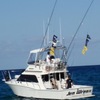I CALL IT THE "MPS"
When the wind doesn't blow the marlin want to go.
I just spoke with a couple of fishermen who stayed at the Los Barriles Hotel and fished a local charter boat for the last three days. The first two days weather was calm and they accounted for 2 striped marlin and 10 dorado. Their last day the wind hooped up and the count was a goose egg.
This is typical for winter time fishing on the East Cape. The bite can be good but is never consistent. I believe all the ups and downs in weather is the largest contributing factor. It has been the same deal fishing for yellowtail. No doubt they are in the neighborhood. One day a guy can go out and bag a couple 30-35 pounders and the next day they are gone. Two or three days later they bite again.
Personally I can't wait to get past February. Entering March we are over the hump and the bite is much more consistent. Warming water and more active bait, turns sea life on. Turns me on also. In March the marlin start to pile up in large schools and sometimes yellowfin tuna make an early showing. Roosterfish become active and the whole sea starts to wake up from winter. It is also when sightings and the shot at a swordfish are at their best. Talk about a turn on!
When I moved to the East Cape in 1991 GPS's were not available and Loran's did not work in this area. Navigating the Sea of Cortez was done with a compass and a wrist watch. The local fishermen would find their sweet spots and relate their location to each other by using a triangulation method. Not knowing the names of mountain peaks or different beach areas, I installed a direction finder on my boat. With that, I could at least tell which direction they were broadcasting from. The direction finder never did work very well but learning the Mexican method has. Now folks will ask how did you find that other boat or sweet spot without your GPS. My anwser is the MPS ...
"Mexican Positioning System".

In the back ground on this picture is a mountain peak called Picacho (translation is peak). It is located behind San Jose airport and prominently stands out from almost anywhere in Palmas Bay. It is almost always used in navigating the East Cape. The low sloping hill in front of Picacho is call Caguama. The literal translation is Loggerhead but the locals use that word for all sea turtles. Use your imagination and the hill looks like a turtle. This location is known at Picacho Y Caguama.

The mountain peak in the backround of this photo is Sierra Alta. It is also a major navigation marker. Straight down on the beach from Sierra Alta is Buenas Aires.
The high spot off La Ribera is right where Picacho y Caguama and Siera Alta y Buenas Aires are all lined up. It is consistently one of the hottest fishing spots on the East Cape.

This location is Releases (the white marks on the mountain) Y Punta Colorada.

Here is a photo of a remora. They are the strange sucker fish we see stuck to the sides of Marlin.


Caught this shrimp boat going to work in front of our place the other evening

We found this cute little coronetfish floating in our bait tank. Poor guy must have gotten trapped in a throw net when a pangero was making sardines

It is hard to find foliage that will thrive and tolerate the salt and wind on the beach. I rescued this Yucca plant from the desert and put it in front of our home. It seems to like the beach as much as me and is flowering to prove it. That is Palmas de Cortez in the back ground.

Can't hardly wait for spring!

Mark Rayor
teamjenwren.com
markrayor.blogspot.com
US cell 310 308 5841

